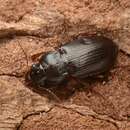Associations
provided by BioImages, the virtual fieldguide, UK
Foodplant / feeds on
larva of Amara aulica feeds on Matricaria
Remarks: Other: uncertain
Plant / associate
Amara aulica is associated with Chamaemelum nobile
Animal / parasitoid / endoparasitoid
larva of Freraea gagatea is endoparasitoid of imago of Amara aulica
Conservation Status
provided by University of Alberta Museums
Information not available.
- license
- cc-by-nc
- copyright
- University of Alberta Museums
Distribution
provided by University of Alberta Museums
Introduced from Europe and has Palearctic distribution. Recorded for the first time in Nova Scotia in 1929 and currently wide spread in Atlantic Canada (Fall, 1934, Lindroth, 1955, Majka, 2005). It is restricted in its range mainly to eastern Canada. Reported from New Brunswick, Newfoundland, Nova Scotia and Quebec (Lindroth, 1955, CBIF, 2010).
- license
- cc-by-nc
- copyright
- University of Alberta Museums
General Description
provided by University of Alberta Museums
Adults are stoutly built, 11 - 14.3 mm in length. Remarkably large head. Prothorax is thicker and darker with slight bronze hue and a key to species identification. It is large, hind prothoracic angles are strongly protruding with densely punctate base. Legs and head appendages are reddish brown. In males, meso-tibiae of legs bear two tubercles which are usually one in number in other species. Elytra are short and widen behind middle (Lindroth, 1968).
- license
- cc-by-nc
- copyright
- University of Alberta Museums
Habitat
provided by University of Alberta Museums
Open meadows, grounds with weedy patches, especially those close to ports and towns. Too dry conditions are not favorable (Lindroth, 1992).
- license
- cc-by-nc
- copyright
- University of Alberta Museums
Life Cycle
provided by University of Alberta Museums
Details on its life history are not available from Canada. However, larvae are noted to hibernate in winter (Lindroth, 1945). Details on life history are available from Europe. In general, oviposition starts late in the season from August to September. First and second instar larvae continue feeding on weed seeds and overwinter in third stadium. Adults emerge late in next summer season (Saska, 2005).
- license
- cc-by-nc
- copyright
- University of Alberta Museums
Trophic Strategy
provided by University of Alberta Museums
Larvae are granivorous. Seed feeding in larval stage is essential for overall growth and development. Adults exhibit similar food preferences as larvae. Adults usually feed on flower heads and unripe seeds of members of family Asteraceae. Adults and larvae together can remove considerable amount of seed from weed plants they feed on. Some important host plants noted include: Cirsium arvense (L.) and Artemisia vulgaris L. (Saska, 2005).
- license
- cc-by-nc
- copyright
- University of Alberta Museums
Amara aulica
provided by wikipedia EN
- license
- cc-by-sa-3.0
- copyright
- Wikipedia authors and editors
Amara aulica: Brief Summary
provided by wikipedia EN
Amara aulica is a species of beetle of the genus Amara in the Harpalinae subfamily. It is native to Europe.
- license
- cc-by-sa-3.0
- copyright
- Wikipedia authors and editors

